2011 NISSAN 370Z ROADSTER roof
[x] Cancel search: roofPage 10 of 419
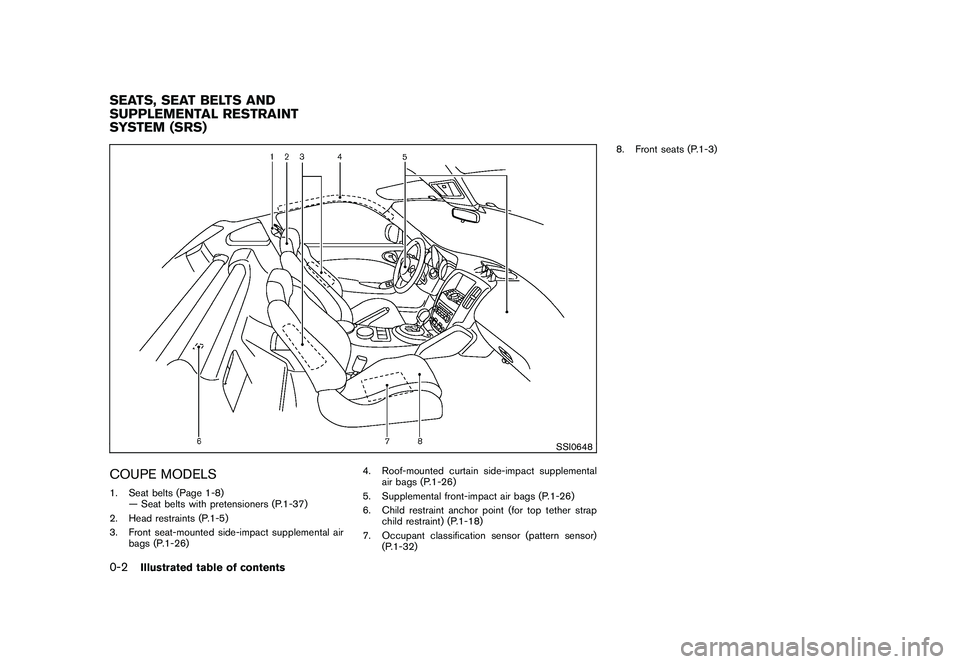
Black plate (4,1)
Model "Z34-D" EDITED: 2010/ 7/ 27
SSI0648
COUPE MODELS1. Seat belts (Page 1-8)— Seat belts with pretensioners (P.1-37)
2. Head restraints (P.1-5)
3. Front seat-mounted side-impact supplemental air bags (P.1-26) 4. Roof-mounted curtain side-impact supplemental
air bags (P.1-26)
5. Supplemental front-impact air bags (P.1-26)
6. Child restraint anchor point (for top tether strap child restraint) (P.1-18)
7. Occupant classification sensor (pattern sensor) (P.1-32) 8. Front seats (P.1-3)SEATS, SEAT BELTS AND
SUPPLEMENTAL RESTRAINT
SYSTEM (SRS)0-2
Illustrated table of contents
Page 23 of 419
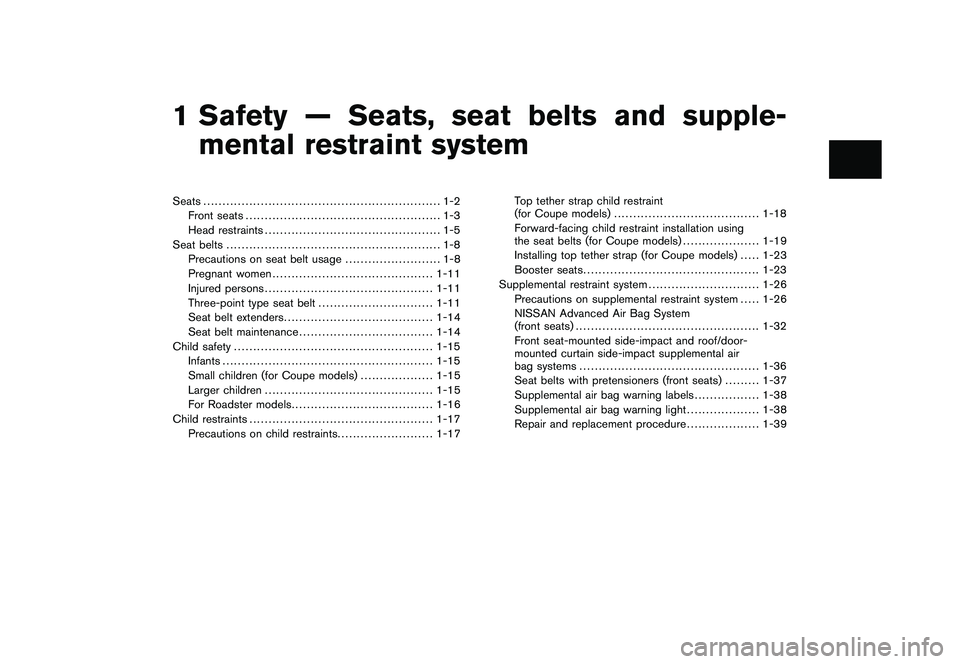
Black plate (4,1)
1 Safety — Seats, seat belts and supple-mental restraint system
Model "Z34-D" EDITED: 2010/ 7/ 28
Seats .............................................................. 1-2
Front seats ................................................... 1-3
Head restraints .............................................. 1-5
Seat belts ........................................................ 1-8
Precautions on seat belt usage ......................... 1-8
Pregnant women .......................................... 1-11
Injured persons ............................................ 1-11
Three-point type seat belt .............................. 1-11
Seat belt extenders ....................................... 1-14
Seat belt maintenance ................................... 1-14
Child safety .................................................... 1-15
Infants ....................................................... 1-15
Small children (for Coupe models) ................... 1-15
Larger children ............................................ 1-15
For Roadster models ..................................... 1-16
Child restraints ................................................ 1-17
Precautions on child restraints ......................... 1-17 Top tether strap child restraint
(for Coupe models)
...................................... 1-18
Forward-facing child restraint installation using
the seat belts (for Coupe models) .................... 1-19
Installing top tether strap (for Coupe models) . .... 1-23
Booster seats .............................................. 1-23
Supplemental restraint system ............................. 1-26
Precautions on supplemental restraint system . .... 1-26
NISSAN Advanced Air Bag System
(front seats) ................................................ 1-32
Front seat-mounted side-impact and roof/door-
mounted curtain side-impact supplemental air
bag systems ............................................... 1-36
Seat belts with pretensioners (front seats) ......... 1-37
Supplemental air bag warning labels ................. 1-38
Supplemental air bag warning light ................... 1-38
Repair and replacement procedure ................... 1-39
Page 48 of 419

Black plate (44,1)
Model "Z34-D" EDITED: 2010/ 7/ 27
and snug on the child’s hips. Be sure to
follow the booster seat manufacturer’s
instructions for adjusting the belt routing.
5. Pull the shoulder belt portion of the seat belt toward the retractor to take up extra slack.
Be sure the shoulder belt is positioned
across the top, middle portion of the child’s
shoulder. Be sure to follow the booster seat
manufacturer’s instructions for adjusting the
belt routing.
6. Follow the warnings, cautions and instruc- tions for properly fastening a seat belt
shown in the “THREE-POINT TYPE SEAT
BELT” earlier in this section.
SSS0988
7. If the booster seat is installed in the frontpassenger seat, push the ignition switch to
the ON position. The front passenger air bag
status light
may or may not illuminate
depending on the size of the child and the
type of booster seat used. (See “Front
passenger air bag and status light” later in
this section.)
PRECAUTIONS ON SUPPLEMENTAL
RESTRAINT SYSTEMThis Supplemental Restraint System (SRS)
section contains important information concern-
ing the driver and passenger front impact
supplemental air bags (NISSAN Advanced Air
Bag System) , front seat-mounted side-impact
supplemental air bag system, roof-mounted
(Coupe models) or door-mounted (Roadster
models) curtain side-impact supplemental air
bag and seat belt with pretensioners.
Supplemental front-impact air bag system:
The NISSAN Advanced Air Bag System can
help cushion the impact force to the head and
chest of the driver and front passenger in certain
frontal collisions.
Front seat-mounted side-impact supple-
mental air bag system: This system can help
cushion the impact force to the chest and pelvis
area of the driver and front passenger in certain
side impact collisions. The front seat side-
impact supplemental air bags are designed to
inflate on the side where the vehicle is impacted.
Roof-mounted curtain side-impact supple-
mental air bag system (for Coupe models):
This system can help cushion the impact force
to the head of the driver and front passenger in
certain side impact collisions. The curtain air
bags are designed to inflate on the side where
the vehicle is impacted.SUPPLEMENTAL RESTRAINT
SYSTEM
1-26
Safety — Seats, seat belts and supplemental restraint system
Page 52 of 419
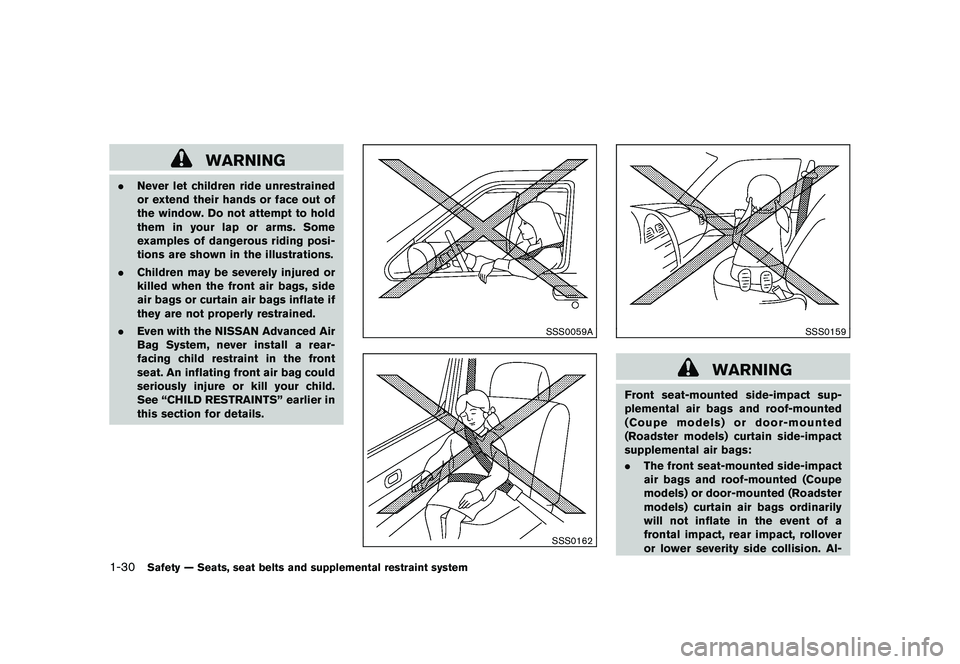
Black plate (48,1)
Model "Z34-D" EDITED: 2010/ 7/ 27
WARNING
.Never let children ride unrestrained
or extend their hands or face out of
the window. Do not attempt to hold
them in your lap or arms. Some
examples of dangerous riding posi-
tions are shown in the illustrations.
. Children may be severely injured or
killed when the front air bags, side
air bags or curtain air bags inflate if
they are not properly restrained.
. Even with the NISSAN Advanced Air
Bag System, never install a rear-
facing child restraint in the front
seat. An inflating front air bag could
seriously injure or kill your child.
See “CHILD RESTRAINTS” earlier in
this section for details.
SSS0059ASSS0162
SSS0159
WARNING
Front seat-mounted side-impact sup-
plemental air bags and roof-mounted
(Coupe models) or door-mounted
(Roadster models) curtain side-impact
supplemental air bags:
.The front seat-mounted side-impact
air bags and roof-mounted (Coupe
models) or door-mounted (Roadster
models) curtain air bags ordinarily
will not inflate in the event of a
frontal impact, rear impact, rollover
or lower severity side collision. Al-
1-30
Safety — Seats, seat belts and supplemental restraint system
Page 53 of 419
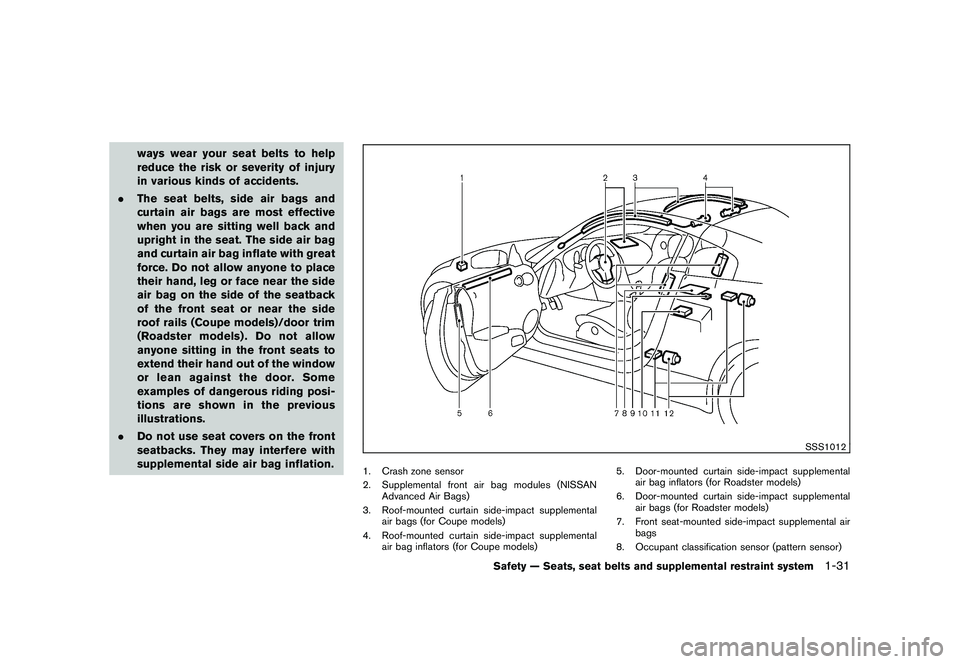
Black plate (49,1)
Model "Z34-D" EDITED: 2010/ 7/ 27
ways wear your seat belts to help
reduce the risk or severity of injury
in various kinds of accidents.
. The seat belts, side air bags and
curtain air bags are most effective
when you are sitting well back and
upright in the seat. The side air bag
and curtain air bag inflate with great
force. Do not allow anyone to place
their hand, leg or face near the side
air bag on the side of the seatback
of the front seat or near the side
roof rails (Coupe models)/door trim
(Roadster models) . Do not allow
anyone sitting in the front seats to
extend their hand out of the window
or lean against the door. Some
examples of dangerous riding posi-
tions are shown in the previous
illustrations.
. Do not use seat covers on the front
seatbacks. They may interfere with
supplemental side air bag inflation.
SSS1012
1. Crash zone sensor
2. Supplemental front air bag modules (NISSAN
Advanced Air Bags)
3. Roof-mounted curtain side-impact supplemental air bags (for Coupe models)
4. Roof-mounted curtain side-impact supplemental air bag inflators (for Coupe models) 5. Door-mounted curtain side-impact supplemental
air bag inflators (for Roadster models)
6. Door-mounted curtain side-impact supplemental air bags (for Roadster models)
7. Front seat-mounted side-impact supplemental air bags
8. Occupant classification sensor (pattern sensor)
Safety — Seats, seat belts and supplemental restraint system
1-31
Page 58 of 419
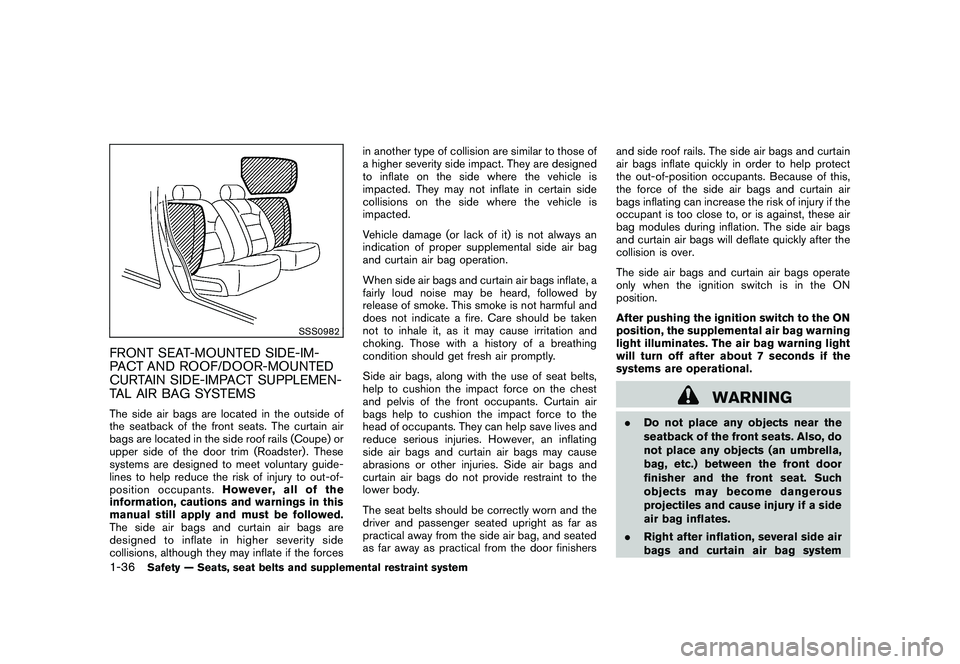
Black plate (54,1)
Model "Z34-D" EDITED: 2010/ 7/ 27
SSS0982
FRONT SEAT-MOUNTED SIDE-IM-
PACT AND ROOF/DOOR-MOUNTED
CURTAIN SIDE-IMPACT SUPPLEMEN-
TAL AIR BAG SYSTEMSThe side air bags are located in the outside of
the seatback of the front seats. The curtain air
bags are located in the side roof rails (Coupe) or
upper side of the door trim (Roadster) . These
systems are designed to meet voluntary guide-
lines to help reduce the risk of injury to out-of-
position occupants.However, all of the
information, cautions and warnings in this
manual still apply and must be followed.
The side air bags and curtain air bags are
designed to inflate in higher severity side
collisions, although they may inflate if the forces in another type of collision are similar to those of
a higher severity side impact. They are designed
to inflate on the side where the vehicle is
impacted. They may not inflate in certain side
collisions on the side where the vehicle is
impacted.
Vehicle damage (or lack of it) is not always an
indication of proper supplemental side air bag
and curtain air bag operation.
When side air bags and curtain air bags inflate, a
fairly loud noise may be heard, followed by
release of smoke. This smoke is not harmful and
does not indicate a fire. Care should be taken
not to inhale it, as it may cause irritation and
choking. Those with a history of a breathing
condition should get fresh air promptly.
Side air bags, along with the use of seat belts,
help to cushion the impact force on the chest
and pelvis of the front occupants. Curtain air
bags help to cushion the impact force to the
head of occupants. They can help save lives and
reduce serious injuries. However, an inflating
side air bags and curtain air bags may cause
abrasions or other injuries. Side air bags and
curtain air bags do not provide restraint to the
lower body.
The seat belts should be correctly worn and the
driver and passenger seated upright as far as
practical away from the side air bag, and seated
as far away as practical from the door finishers
and side roof rails. The side air bags and curtain
air bags inflate quickly in order to help protect
the out-of-position occupants. Because of this,
the force of the side air bags and curtain air
bags inflating can increase the risk of injury if the
occupant is too close to, or is against, these air
bag modules during inflation. The side air bags
and curtain air bags will deflate quickly after the
collision is over.
The side air bags and curtain air bags operate
only when the ignition switch is in the ON
position.
After pushing the ignition switch to the ON
position, the supplemental air bag warning
light illuminates. The air bag warning light
will turn off after about 7 seconds if the
systems are operational.
WARNING
.
Do not place any objects near the
seatback of the front seats. Also, do
not place any objects (an umbrella,
bag, etc.) between the front door
finisher and the front seat. Such
objects may become dangerous
projectiles and cause injury if a side
air bag inflates.
. Right after inflation, several side air
bags and curtain air bag system
1-36
Safety — Seats, seat belts and supplemental restraint system
Page 60 of 419
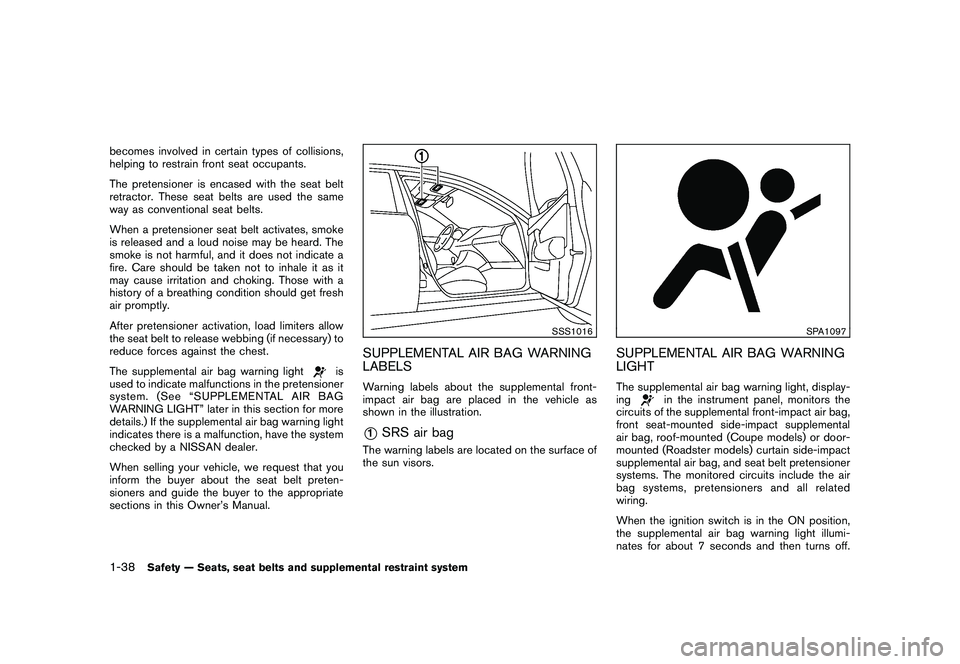
Black plate (56,1)
Model "Z34-D" EDITED: 2010/ 7/ 27
becomes involved in certain types of collisions,
helping to restrain front seat occupants.
The pretensioner is encased with the seat belt
retractor. These seat belts are used the same
way as conventional seat belts.
When a pretensioner seat belt activates, smoke
is released and a loud noise may be heard. The
smoke is not harmful, and it does not indicate a
fire. Care should be taken not to inhale it as it
may cause irritation and choking. Those with a
history of a breathing condition should get fresh
air promptly.
After pretensioner activation, load limiters allow
the seat belt to release webbing (if necessary) to
reduce forces against the chest.
The supplemental air bag warning light
is
used to indicate malfunctions in the pretensioner
system. (See “SUPPLEMENTAL AIR BAG
WARNING LIGHT” later in this section for more
details.) If the supplemental air bag warning light
indicates there is a malfunction, have the system
checked by a NISSAN dealer.
When selling your vehicle, we request that you
inform the buyer about the seat belt preten-
sioners and guide the buyer to the appropriate
sections in this Owner’s Manual.
SSS1016
SUPPLEMENTAL AIR BAG WARNING
LABELSWarning labels about the supplemental front-
impact air bag are placed in the vehicle as
shown in the illustration.*1
SRS air bag
The warning labels are located on the surface of
the sun visors.
SPA1097
SUPPLEMENTAL AIR BAG WARNING
LIGHTThe supplemental air bag warning light, display-
ing
in the instrument panel, monitors the
circuits of the supplemental front-impact air bag,
front seat-mounted side-impact supplemental
air bag, roof-mounted (Coupe models) or door-
mounted (Roadster models) curtain side-impact
supplemental air bag, and seat belt pretensioner
systems. The monitored circuits include the air
bag systems, pretensioners and all related
wiring.
When the ignition switch is in the ON position,
the supplemental air bag warning light illumi-
nates for about 7 seconds and then turns off.
1-38
Safety — Seats, seat belts and supplemental restraint system
Page 105 of 419

Black plate (101,1)
Model "Z34-D" EDITED: 2010/ 7/ 27
SIC3288
Automatic operationTo fully open or close the window, completely
push down or pull up the switch and release it; it
need not be held. The window will automatically
open or close all the way. To stop the window,
just push or lift the switch in the opposite
direction.
A light push or pull on the switch will cause the
window to open or close until the switch is
released.
Auto reverse function
WARNING
There are some small distances imme-
diately before the closed position which
cannot be detected. Make sure that all
passengers have their hands, etc., in-
side the vehicle before closing the
window.
If the control unit detects something caught in
the window as it is closing, the window will be
immediately lowered.
The auto reverse function can be activated when
the window is closed by automatic operation
when the ignition switch is in the ON position or
for 45 seconds after the ignition switch is
pushed to the OFF position.
Depending on the environment or driving
conditions, the auto reverse function may
be activated if an impact or load similar to
something being caught in the window
occurs.
Automatic window lowering (Roadster
models)When the soft top operating switch is pressed,
the power windows will automatically be low-
ered completely. The windows do not rise
automatically after the soft top open/close
operation is completed. Use the power window
switches to raise them.Automatic adjusting function
CAUTION
When the battery cable is removed from
the battery terminal, do not close either
of the front doors. The automatic win-
dow adjusting function will not work
and the side roof panel may be da-
maged.
The power window has an automatic adjusting
function. When the door is being opened, the
window is automatically lowered slightly to avoid
contact between the window and the side roof
panel. When the door is closed, the window is
automatically raised slightly.
While the automatic adjusting function does not
work, the window will be controlled as follows:
. When the door is opened, the window
lowers for approximately 2 seconds.
Instruments and controls
2-43